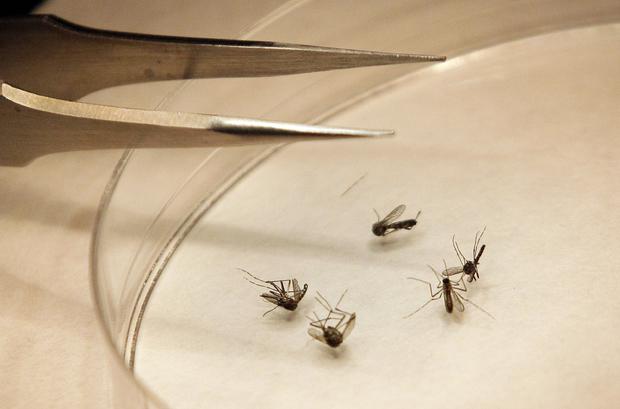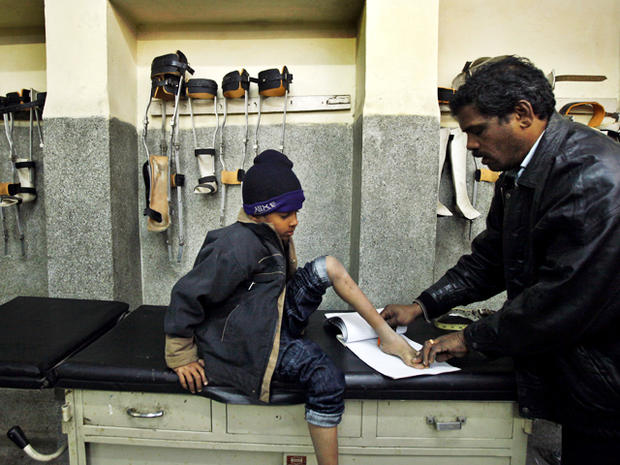CDC year in review: Public health in 2012
The Centers for Disease Control and Prevention is a government organization tasked with protecting public health and promoting a healthy lifestyle free of disease and disability through a focus on preventive health.
Whether it's tracking obesity and disease rates, conducting studies for its Morbidity and Mortality Weekly Report journal, creating multimedia campaigns to curb U.S. smoking rates or work with high-risk communities stop the spread of HIV, the CDC has a major rule in public health issues that affect not only the United States but the whole world.
The CDC has just unveiled its 2012 year in review, which the agency put together to show how it has been involved in some of the most omnipresent public health issues. Keep clicking to find out more...
Multistate fungal meningitis outbreak
In September, 2012 reports emerged of patients who had been treated with steroid injections for back pain developing rare cases of meningitis caused by fungus in addition to other infections.. An investigation by the CDC, FDA and local health departments eventually traced the infections back to methylprednisolone acetate injections made by the New England Compounding Center of Framingham, Mass., that up to 14,000 patients may have received.
The CDC has continued to update the public on the types of infections linked to the outbreak and number of those infected. As of mid Dec., more than 600 people have been sickened and 39 people have died.
CBS News medical correspondent Dr. Jon LaPook visited the CDC's Atlanta headquarters at the height of the outbreak, where roughly 200 staffers worked around the clock to conduct tests and try to slow the outbreak. With help from local health departments, almost everyone who received injections were contacted.
Federal lawmakers are mulling changes as a result of the outbreak that would give the Food and Drug Administration more authority in regulating drug compounding pharmacies that mix doses of drugs for patients.
West Nile virus
Working with local government agencies, the CDC determined there have been 5,387 human disease cases of the virus reported as of the second week in December -- probably the second largest outbreak since the disease first appeared in the U.S. in 1999. To put that number in perspective, there have been 2,845 cases of human West Nile virus over the entire past ten years.
Throughout, CDC officials warned people to wear insect sprays and reduce their risk by wearing long sleeves and urged the removal of standing water puddles where mosquitoes lay eggs. Unfortunately, some people who were infected with the virus, especially the neuroinvasive type that could cause swelling of the brain, may feel long-term effects from their infections.
Healthcare-associated infections
A former traveling lab technician David Kwiatkowski was accused in 2012 of being a "serial infector" of hepatitis C after using painkiller needles on himself then putting them back for use on patients of New Hampshire's Exeter Hospital.
This past summer, Colorado dentist Dr. Stephen Stein was accused of reusing needles at his oral surgery practice, potentially putting more than 10 years worth of patients at risk.
More than 150,000 patients have been impacted by unsafe injection practices since 2001; causing irreparable damage by exposing patients to bloodborne illnesses, such as hepatitis and HIV, and to life-threatening bacterial infections. The CDC routinely investigates such outbreaks and released its "One & Only Campaign" to empower patients and health care providers to insist on nothing less than safe injections -- every time, for every patient.
Foodborne illnesses
CDC scientists are constantly monitoring foodborne illnesses -- up to 40 potential foodborne disease clusters each week -- and investigate more than 200 multistate clusters of foodborne illness to determine causes of outbreak and how to stop them from spreading.
This year, the CDC investigated a salmonella outbreak tied to Trader Joe's Valencia Creamy Peanut Butter that sickened 42 people in 20 states. The outbreak eventually led to the recall of hundreds of products produced by Sunland, Inc., one of the largest organic peanut processors in the United States.
One of the newest and most promising programs the CDC uses to detect these outbreaks is the FoodCore program, which performs comprehensive foodborne disease surveillance and conducts rapid, coordinated detection and response to multistate outbreaks in seven locations nationally.
Ebola
The outbreak was tied to a funeral for a 3-month-old girl with Ebola, because 15 people who attended later developed the disease that causes intense weakness, muscle pain, headache, sore throat and in some cases bleeding.
Laboratory tests of blood samples, conducted by the Uganda Virus Research Institute and the CDC confirmed Ebola virus in 11 patients, four of whom died.
A total of 24 human cases (probable and confirmed only), 17 of which were fatal, were reported since the beginning of July, the World Health Organization said in October when it declared the outbreak over.
Rabies
Untreated rabies virus is usually fatal without getting the necessary vaccinations following a bite from an infected animal. However, In August of 2012, a CDC study found some people living in two Amazon communities in Peru survived being exposed to the rabies virus by naturally fighting it off.
The study found strong evidence that an immune response may occur in certain communities where people are regularly exposed to the virus. Still, avoiding rabid animal exposures is the best way to avoid getting this deadly disease.
Also in August 2012, the CDC reported on a rabies scare in an issue of Morbidity and Mortality Weekly Report when a bat made its way on an Atlanta-bound flight before getting trapped in a lavatory. Fortunately, the CDC found no evidence of rabies in passengers and crew members.
Influenza
The United States is seeing the earliest flu season in nearly a decade, the CDC said in December, but survey data show that more than half of the U.S. population has not gotten a flu vaccine, leaving them vulnerable to infection possibly serious illness and to spreading influenza to others.
"CDC is committed to increasing awareness about the dangers of influenza and adherence to vaccine and early treatment recommendations, especially among people who are at greater risk for serious flu complications if they become ill," the agency said.
The CDC tracks influenza rates in its weekly FluView surveillance report.
Polio
The number of worldwide polio cases has fallen from an estimated 350,000 in 1988 to fewer than 1,300 in 2010--a decline of more than 99 percent, according to recent CDC data.
Tips from former smokers
While the FDA was battling tobacco companies in the courts to force graphic warning labels on cigarette packs in 2012, the CDC unveiled its "Tips From Former Smokers" national ad campaign on March 15 to bring even more attention to the human suffering caused by smoking by encouraging smokers to quit with the graphic videos and ads.
One ad showed Terrie, a 51-year-old woman who began smoking in high school and had her larynx removed at age 40 because of throat cancer.
During the 12-week campaign, the CDC said it saw a record number of calls to the national quitline 1-800-QUIT-NOW and visits to smokefree.gov. The agency plans to launch new ads in 2013.
Prescription Drug Overdose
A CDC study in July found methadone accounted for more than 30 percent of prescription painkiller overdose deaths despite accounting for only 2 percent of painkiller prescriptions.
The CDC said it has taken steps to respond to the abuse of prescription drugs by tracking abuse and overdose trends, working with stakeholders to improve clinical care, and evaluating the impact of efforts to prevent overdoses.
Hurricane Sandy
The agency also warned of risks after the storm, including carbon monoxide poisoning from improper use of generators.
When a disaster occurs, NCEH is ready to respond and supports national, state, and local partners to save lives and reduce suffering, while helping these partners recover and restore public health functions after the initial response. In late 2012, NCEH played a role in responding to Hurricane Sandy by delivering accurate and timely preparedness and response information to the public, our partners, and the media by using the web, social media, and traditional media, according to the CDC.
NFL study on traumatic brain injury
In addition, when line and non-line positions were compared, non-line position players -- or "speed" players -- had a higher risk of neurodegenerative death than linemen. Researchers noted that the study can't prove that the results were caused by football-related concussions, and that they may not apply to pro or amateur players who've played fewer than five years.
Sleep deprivation study
Insufficient sleep can have serious and sometimes fatal consequences for fatigued workers and others around them, according to the CDC. And a study in April by the National Institute for Occupational Safety and Health found more than 40 million workers get fewer than six hours of sleep each evening -30 percent of the country's workforce.
The prevalence of short sleep duration varied. Forty-four percent of night-shift workers reported not getting enough sleep with the highest rates seen among workers in the transportation or warehouse industries, followed by health care and social assistance workers.
Targeted interventions, such as shift systems that maximize sleep opportunities and training programs on sleep for managers and employees should be implemented to protect the health and safety of workers and the public, the CDC says.










